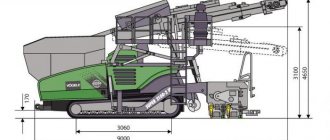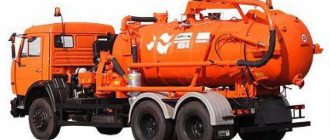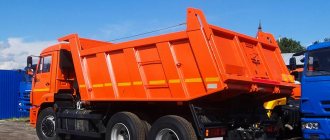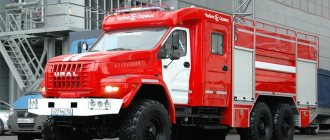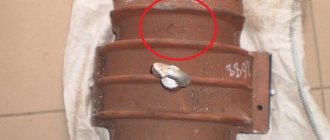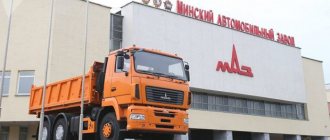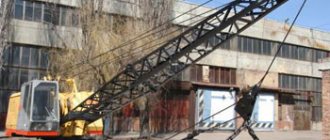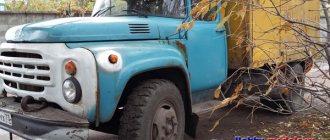Sludge pumps (IVR) are used on secondary radial settling tanks of the biological wastewater treatment system and are designed to remove settling activated sludge. Operating conditions – moderate climate U1 (-45…+450 C) according to GOST 15150-69. The main model range is IVR-16, IVR-18, IVR-20, IVR-24, IVR-28, IVR-30, IVR-40.
A distinctive feature of the equipment are the following technical solutions that serve to improve performance characteristics, reduce operating costs and increase service life:
The design must be tied to the dimensions of the existing building part of the sump. This allows installation work to be carried out in a short time without adjusting parts and assemblies “in place”;
The design is more stable and rigid compared to the standard one. This is achieved by using a high-strength bridge truss and a motion drive trolley on 2 wheels (the mass of the moving part is distributed over 3 points - the wheels and the central support). The stability of the structure ensures ease of maintenance of the sump, increases the service life of bearings and wheels;
The design of the bridge truss eliminates the possibility of deformation during operation, which does not require additional reinforcement (unlike a standard bridge);
The standard delivery set includes a control cabinet and a current collector with top power supply.
High-quality imported components are used - geared motors complete with frequency converters "NORD", Germany (N in the designation). A frequency converter is used to adjust the required speed and ensure a smooth start (M in the designation);
The motion drive trolley is equipped with 2 wheels from a forklift with solid “superelastic” tires that can withstand loads of up to 3000 kg and have high wear resistance (2 in the designation);
A device is installed to clear snow from the treadmill (C in the designation), which prevents freezing of the treadmill;
The equipment has a Declaration of Conformity with the requirements of the technical regulations of the Customs Union TR CU 010/2011 “On the safety of machinery and equipment.”
Sludge pumps based on KAMAZ, MAZ, ZIL, GAZ - technical characteristics of sludge suckers
The table of sludge-suction machines contains sludge-sucker barrels with vacuum sewer and water plunger pumps based on KAMAZ, MAZ, ZIL-431412, GAZ-3309 trucks, indicating the technical characteristics of the sewer truck (barrel volume, water tank capacity, pump performance, fuel consumption, type of chassis - highway/all-terrain vehicle, hose type), manufacturer's name. The tabular form allows you to quickly select and buy a sludge pump directly from the manufacturer at the best price.
Combined suction pumps KROLL based on MAN, Mercedes, Scania - technical characteristics of suction machines
Vacuum suction pumps based on KAMAZ, MAZ, ZIL - technical characteristics of suction machines
Sludge pumps based on KAMAZ, MAZ - technical characteristics of sludge suckers
Buy a sludge pump (sludge sucker) directly at the manufacturer’s price
Buy a new combined suction pump
KAMAZ, MAZ, ZIL, GAZ, Gazelle with a pump, hose-sleeve with a volume of 3 to 10 cubic meters became available using the online catalog "SPECIAL EQUIPMENT" at the selling price of the manufacturer, thanks to the published addresses of manufacturers, official websites, telephone numbers of the sales department of each manufacturer .
The provided contact information allows you to quickly agree on the terms of direct delivery of the sludge sucker, a possible discount on the manufacturer’s selling price, draw up a sales contract directly without resellers and buy
the suction pump selected from the catalog in the sales department at the price indicated in the price list of the manufacturer.
List of manufacturing plants of sludge suckers
(sludge sucking machines)
from Russia, Germany:
"COMMASH" Mtsensk plant OJSC, Mtsensk, Russia
What are the consequences of excess moisture in the soil?
You can see the results of this phenomenon yourself - trees and shrubs die. Why is this happening?
- the oxygen content in the soil decreases and the carbon dioxide content increases, which leads to disruption of air exchange processes, water regime and nutritional regime in the soil;
- oxygen starvation of the root-forming layer occurs, which leads to the death of plant roots;
- the supply of macro and microelements by plants (nitrogen, phosphorus, potassium, etc.) is disrupted, because excess water washes out mobile forms of elements from the soil, and they become unavailable for absorption;
- intensive breakdown of proteins occurs and, accordingly, the processes of decay are activated.
Plants can tell you at what level groundwater lies
Take a close look at the flora of your area. The species inhabiting it will tell you at what depth the groundwater layers are located:
- perched water - it is best to dig a reservoir in this place;
- at a depth of up to 0.5 m - marigold, horsetails, varieties of sedges grow - bladderwrack, holly, foxtail, Langsdorff's reed;
- at a depth of 0.5 m to 1 m - meadowsweet, canary grass, ;
- from 1 m to 1.5 m – favorable conditions for meadow fescue, bluegrass, mouse peas, rank;
- from 1.5 m - wheatgrass, clover, wormwood, plantain.
What is important to know when planning site drainage
Each group of plants has its own moisture needs:
- with a groundwater depth of 0.5 to 1 m, vegetables and annual flowers can grow in high beds;
- depth of water layer up to 1.5 m is well tolerated by vegetables, grains, annuals and perennials (flowers), ornamental and fruit shrubs, trees on a dwarf rootstock;
- if the groundwater is more than 2 m deep, fruit trees can be grown;
- The optimal depth of groundwater for agriculture is from 3.5 m.
Is site drainage necessary?
Record your observations for at least some time. You yourself can understand how much drainage is needed.
Maybe it makes sense to simply redirect melt and sediment water along the bypass channel, rather than allowing it to flow through your site?
Perhaps it is necessary to design and equip a storm drain and improve the composition of the soil and this will be enough?
Or is it worth making a drainage system only for fruit and ornamental trees?
A specialist will give you the exact answer, and we strongly recommend calling him. But after reading this article, you will gain some awareness on this issue.
Upon completion of the technological and production tasks associated with the arrangement of a sewer system in an apartment building, industrial building, as well as in a private household, it is necessary to test the involved system using the forced flow method. This task is used to identify possible defects or improper installation of the entire involved sewerage part, and the test report for internal sewerage and drainage systems will be material evidence of the work on acceptance of the facility.
A visual inspection should be accompanied by inclusion in the test report of internal sewerage and drainage systems according to SNIP, which is currently represented by the current regulations of the “D” series appendix, which corresponds to SP 73.13330.2012 “Internal sanitary systems of a building”, recently a new one has been applied updated working edition according to SNiP 3.05.01-85.
| The sludge sucker catalog includes new sludge suckers KAMAZ, MAZ, ZIL, GAZ, Gazelle, Scania, MAN, Mercedes from the best Russian manufacturers of the following brands: KO-507, KO-510, KO-524, KO-530, KO-560 , TCM, Kroll, Moro (Moro). |
Sludge cleaner KO-507 based on KamAZ
The KO 507 machine is a special municipal equipment that is used to carry out cleaning work. It is used in sewer systems, storm drains and drains. A special mechanical device allows you to remove sludge, sludge water and fatty deposits from wells and cesspools. In addition to pumping out contaminants, the KAMAZ-based vehicle is designed to transport the collected mass for the purpose of its subsequent disposal. The sludge pump based on KamAZ KO 507 has the following features:
- A powerful vacuum pump allows you to cope even with heavy and dense sludge, ensuring an environmentally friendly and leak-tight process.
- The tank for collected sludge is equipped with a lid on the back. It folds back when unloading sludge and simplifies the process of emptying the container.
Photo of the KO-507 suction pump based on KamAZ
Video gallery
Machines for cleaning storm drains from sludge, their technical capabilities and features.
The maintenance of city communications that provide storm drains is associated with the periodic cleaning of sewage wells and collectors from the resulting sludge. Its appearance in storm drain networks is inevitable, since this mixture of road dust and various insoluble particles with rainfall is constantly formed and, due to its gravity, is deposited on the walls of pipelines and in the pockets of wells. This pulp can only be removed with the help of a special sludge sucking machine, which allows you to extract sludge deposits from the most inaccessible places in stormwater networks.
Device
Sludge cleaner ko 507 uses a unique vacuum method for cleaning sewers, cesspools and treatment facilities. The main element of the equipment is the chassis, which is responsible for moving the entire sludge suction system. The collected waste is stored in a tank. Sludge collection and unloading is carried out by sequentially launching a vacuum and pressure system. The tank itself is internally divided into two blocks. The front unit is filled with clean water, while the rear unit collects sludge and silt liquid. During transportation, solid sludge deposits move to the rear of the tank, and liquid settles in the front of the block. That is why waste is discharged through the back cover. For better cleaning of the container, you can install a mechanical piston, which forcibly pushes contaminants out.
The suction hose of the suction cleaner is equipped with a boom with a winch. These devices provide control of the hose and its fixation on the tank during transportation. The hose is controlled and its position is changed from the cabin using special devices located on the panel.
The sludge pump KO 507 allows you to install additional equipment for filtering and cleaning the collected sludge. This system processes sludge so that the output is process water. It can be used for public utility needs.
How does a sludge sucker work?
The suction pump contains:
- high pressure vacuum and plunger pump for pumping out waste;
- a suction hose (boom) that allows waste to be collected from depth;
- gun for washing away silt and viscous sediments;
- tank for collection and removal of waste; can also be used for recycling and temporary
- storage of sludge deposits;
- additional equipment (hoses, extension cords, water tanks).
The principle of operation of the suction pump is simple - with the help of a vacuum pump, waste enters the suction hose and then into the storage tank (cistern) . As the waste separates, water is formed in the tank, which enters a special compartment where it settles and clarifies. To increase the capacity of the tank, excess water is drained through a special pipe. This water is not dangerous and can be used to water garden plants or be drained into a ditch, pond, or forest area.
If you watch a video of how the sludge pump works, you can see that one person is enough to control the process (usually the driver). The machine drives as close as possible to the pumping site, then the suction hose unwinds and lowers into the container to be pumped. After this, just press the start button of the vacuum pump and monitor the filling level of the tank, draining the water in time.
Usually the whole process takes about 30 minutes, of which pumping takes from 3 to 7 minutes.
Waste is transported to special sites (sludge dumps or landfills). On sludge pads, waste is dried and disposed of or sent for processing (fertilizers are made from it). Waste is evacuated through the rear hinged lid of the tank. Some models are equipped with hydraulic devices to push waste out, but more often the discharge occurs under the influence of gravity.
Some numbers:
- The average pumping depth is up to 30 m.
- The volume of the tank is about 3 m3.
- The average hose length is 50-60 m.
- The average hose diameter is 100 mm.
Difference from a sewer truck
People unfamiliar with the process of collecting waste on a professional level often ask the question of how a sludge extractor differs from a vacuum cleaner. These machines are indeed very similar in design and differ only in that the suction pumps are additionally equipped with a gun for washing away viscous deposits. This allows you to effectively clean sedimentation tanks, ponds and wells, while sewage disposal technology is only suitable for septic tanks and cesspools, where the waste has a lower density and a more uniform consistency.
Features of gas connections
When connecting gas stoves, water heaters and other types of equipment, flexible hoses are also used. Unlike water models, they are yellow and are not tested for environmental safety. For fixation, end steel or aluminum reinforcement is used. There are the following types of devices for connecting gas appliances:
- PVC hoses reinforced with polyester thread;
- made of synthetic rubber with stainless steel braid;
- bellows, made in the form of a corrugated stainless steel tube.
The Santekhkomplekt holding offers engineering equipment, fittings, plumbing fixtures and devices for connecting them to communications. The assortment is represented by products and materials from well-known foreign and domestic manufacturers. Discounts apply for bulk purchases, and product quality is confirmed by standard certificates. For information support and assistance, each client is assigned a personal manager. The ability to arrange delivery within Moscow and to other regions of the Russian Federation allows you to quickly receive the purchased goods without unnecessary hassle.
Drainage is a drainage and drainage measure to remove excess groundwater.
If water does not leave the site for a long time, the soil becomes gleyed, if shrubs and trees quickly disappear (get wet), you need to urgently take action and drain the site.
Popular suction pump models
On the Russian market, domestically produced models are most in demand. Power, spaciousness, affordable price and excellent maneuverability make them indispensable when working both within the city and in rural areas and at remote sites:
- KO 507AM is ideal for cleaning clogged pipes and utility networks, including removing grease-containing sediments. It is installed on a KamAZ base, holds up to 7 m3 of waste, and collection is possible from a depth of up to 6 m.
- KO 510 is a machine with a compact tank of 3.25 m3. Mounted on a ZIL chassis, the sludge extractor does an excellent job of cleaning wells and sewer systems. Cleaning depth is up to 4.5 m. Equipped with tanks for water (20 l) generated during waste collection.
- KO-530 is a powerful and capacious sludge pump based on KamAZ with a tank of 9.7 m3. It can be equipped with additional tanks, hoses and extensions, which allows you to work at greater depths. One of the most productive sludge sucking machines today.
- KO 560 with a volume of 6000 l belongs to the combined machines. In the basic version, they are equipped with sludge sucking and sewer cleaning equipment. They are notable for the fact that you can additionally install a blade and a watering system, after which the sludge suckers can be used as snow blowers, sprinklers and even fire engines. Installed on KamAZ chassis.
Specifications
As an example, let’s look at the technical characteristics of the KO 510 sludge extractor. This is one of the most popular machines, which can be easily recognized in the photo by its ZIL chassis.
Dimensions:
- length - 7000 mm;
- width - 2500 mm;
- height - 3100 mm.
Total weight - 11000 kg. The base chassis is ZIL-432932. Pumping depth - 4.5 m. Tank volume - 3.25 m3. The productivity of the vacuum pump is 360 m3/h. The maximum vacuum in the tank is 0.085 MPa. Tank filling time - 3-6 minutes
"Imported" competitors
Specialized sludge sucking machines are supplied to our market by the well-known German company Kroll Fahrzeugbau-Umwelttechnik GmbH. Kroll sludge suckers are sold by the official representative of the company - Moscow.
To eliminate sludge deposits, clean sedimentation tanks and wells, Kroll offers a model that is based on the Man or Mercedes chassis. The tank capacity is 18 m3, there is also a tank with a volume of about 1 m3 for clean water. However, the manufacturer is ready to fulfill any customer wishes, and the volume of the tank may be different.
The suction pump uses a vacuum pump with a capacity of 3000 m 3 /h. When unloading, the back cover opens upward using a hydraulic cylinder and is locked in the transport state with a pneumatically controlled central lock. Unloading occurs by gravity, due to the tilting of the tank by the hydraulic cylinder rod. At the buyer's request, Kroll can also install a pneumatic piston unloading system.
In addition, Kroll offers a lot of additional equipment and various systems. This includes a system for draining residual water, a tray with tools, a water level alarm, additional hoses, as well as a spray gun for washing away deposits, the machine pump creates a jet pressure of up to 150 MPa, etc.
The Western market offers a wide range of sewer cleaning machines. These are mainly combined machines, since their use is much cheaper than the use of specialized sludge sucking and sewer washing machines for the same work. However, for large volumes of work, a “division of labor” may be necessary. The Kaiser Aquastar suction machine is an extremely versatile municipal equipment.
The machine from the Austrian company Kaiser is sold in Russia by PSM-Techno LLC from Krasnodar. Kaiser Aquastar is equipped with a Kaiser vacuum pump with a capacity of 3100 m 3 /h. Using the KWP system, the pump performance can be increased by 2 times, up to 6200 m 3 /h.
Kaiser's remote control system operates within a range of 50 to 120 m, depending on the surrounding terrain. When the driver moves out of communication range, all controls are locked. Communication between the transmitter and digital receiver is carried out without interference from random radio signals. The hose winding and unwinding control is pneumatic. The control panel is equipped with a battery, the capacity of which is sufficient for at least 2 work shifts of continuous operation, and charging can be done either from a 220 V network or directly from the on-board network of the machine.
Although Kaiser Aquastar is positioned as a sludge sucker, it has very wide capabilities. Thanks to the selection of different fence booms, the machine can be used equally effectively for many tasks.
The installed high-pressure pump supplies water with a capacity of up to 30 m 3 /h or, optionally, up to 50 m 3 /h and creates a pressure of 20.26 MPa. The Rotomax system allows water to be reused in the cleaning system, which is why Kaiser machines are called the environmental standard for sewer cleaning machines. A dry-type vacuum device allows these machines to be used even when cleaning streets.
But perhaps the most popular among foreign suppliers of sewer cleaning machines in Russia today are machines from the Italian company MORO. The quality and popularity of MORO products is explained by the vast experience of the company, which has been developing vacuum equipment since 1955, and in general the birth of MORO dates back to 1882. The acquisition of Johnston Sweeper technology in 1972 allowed MORO to raise the production of municipal machines to a whole new level.
MORO's representative in Russia - Moscow - has the ability to quickly supply not only excellent sludge-suction machines from this manufacturer, but also sewer-washing machines, MORO vacuum loaders, as well as combined sewer-washing and sludge-suction machines, the use of which is very common in Europe.
The modern design of the new model range of MORO machines designed for the maintenance of sewer and utility networks attracts the attention of not only specialists, but also ordinary people. The reverent attitude of Italians to the appearance of everything that surrounds them is widely known, but in this case, in addition to the aesthetic component, the design of MORO special equipment is determined by the technical and operational requirements for this type of equipment.
The aesthetics and high level of the manufacturer can be seen in the names of the series of machines: these are Colibri - compact combined sewer washing machines with a total weight of only 3.5 tons; Elegance is the most popular series of sludge sucking and sewer cleaning machines (weighing from 12 to 18 tons). Sewer cleaning machines with increased productivity weighing from 25 to 32 tons can be immediately identified by their formidable name - Tornado. The MORO model range is extensive - there are 34 basic models, but at the request of the client, you can assemble a machine to perform any tasks necessary for him according to individual technical specifications. According to the tradition of the MORO concern, the material used for the manufacture of tanks is AISI 304 stainless steel. The sludge compartment for different models holds from 1200 l (Colibri) to 14,000 l (Tornado). The system of compartments for clean water is arranged as follows: the main tank with a capacity of 600 to 7000 liters is located in the front part, and additional polyethylene tanks are located on the sides of the tank.
The characteristics of MORO sewer cleaning machines are such that you can choose a model that will help you in any specific conditions and for any volume of work.
Elegance series machines are equipped, as a rule, with two pumps: a vacuum and a high-pressure pump, creating a pressure in the system of 240 bar, protected by special hatches from the adverse effects of the environment, but not impeding access and maintenance. All MORO machines are equipped with stainless steel drums with automatic closers for 3/4″ and 1/2″ high pressure hoses. Special pencil cases built into the body are designed for storing sleeves. An upper hydraulic telescopic boom with a rotation angle of 360° is designed for the suction hoses. Taking into account the specifics of the work being carried out, an electric winch was installed on the vehicle to lift road hatches.
Experts will appreciate the availability of a number of systems in MORO machines, such as pneumatic drainage of water from water lines, heating of water with an autonomous WEBASTO diesel burner, and water circulation in the system. In the machine control system, everything is thought out to the smallest detail, ergonomic and functional, which makes the operator’s work efficient and accurate. For the convenience of the operator, the possibility of remote control is provided using a multifunctional radio remote control. Everything is thought out for maximum productivity. In terms of price-quality ratio, combined sewer washing machines produced by MORO are the best offer on the market today.
KAMAZ sludge cleaner
Every owner of a private country house or a personal plot on the territory of which wells, cesspools or other artificial or natural reservoirs are located knows that they inevitably silt over time. In this case, it is necessary to clean them and put them in order. Some people prefer to do the entire complex of work manually. It must be said that cleaning a reservoir from silt deposits is truly a difficult task. This is really hard and long work. That is why most people prefer to use the services of a suction pump.
A sludge extractor is a specialized technique that is designed to clean communications, wells, sedimentation tanks, cesspools, and so on using special equipment. Such machines are widely used not only for cleaning and pumping, but also for transporting industrial water for the needs of public utilities. In this article we will tell you about the most common sludge suckers that are installed on the Kamaz chassis.
Causes of soil waterlogging
There are several reasons for soil waterlogging:
- clay heavy soil structure with poor water permeability;
- aquifer in the form of gray-green and red-brown clays is located close to the surface;
- high groundwater table;
- technogenic factors (construction of roads, pipelines, various objects) that interfere with natural drainage;
- disruption of the water balance by the construction of irrigation systems;
- The landscape area is located in a lowland, ravine, or hollow. In this case, precipitation and the influx of water from higher places play a big role.
Accessories
Each device has its own elements, without which work is simply impossible. Ilosos is no exception. It consists of the following components:
- a chassis designed to transport the system itself, water, and waste;
- waste storage tank;
- a hose through which water and waste are pumped out;
- pump, with the help of which all receiving and distributing work is carried out;
- boom and winch for hose control;
- control panel, on which all the necessary indicators and the control system itself are located;
- various additional equipment designed to speed up and facilitate the work performed.
As a rule, KAMAZ-based sludge pumps are equipped with fairly large tanks with the ability to install additional water tanks and so on. The large carrying capacity of such a vehicle allows you to pump out and transport a significant amount of waste (up to 10 cubic meters).
Characteristics and types
The flexible hose for connecting plumbing is a hose of different lengths made of non-toxic synthetic rubber. Thanks to the elasticity and softness of the material, it easily takes the desired position and allows installation in hard-to-reach places. To protect the flexible hose, there is an upper reinforcing layer in the form of a braid, which is made from the following materials:
- Aluminum. Such models can withstand no more than +80 °C and retain functionality for 3 years. At high humidity, aluminum braiding is prone to rust.
- Of stainless steel. Thanks to this reinforcing layer, the service life of the flexible water line is at least 10 years, and the maximum temperature of the transported medium is +95 °C.
- Nylon. This braid is used for the manufacture of reinforced models that can withstand temperatures up to +110 °C and are designed for intensive use for 15 years.
The fasteners used are nut-nut and nut-fitting pairs, which are made of brass or stainless steel. Devices with different permissible temperatures differ in the color of the braid. Blue ones are used to connect to a pipeline with cold water, and red ones for hot water.
When choosing a water line, you need to pay attention to its elasticity, reliability of fasteners and purpose. It is also mandatory to have a certificate that prevents the rubber from releasing toxic components during operation.
The most common sludge sucking machines based on KAMAZ meringues
There are several types of devices that are used for pumping waste and cleaning sewers, wells, sumps, cesspools, and so on. We will talk about the most common of them.
- KO-507a.
- KO-510.
- Ko-524.
- KO-530.
Let's look at each of them in more detail.
KO-507a
The KO-507a sludge sucker is a fairly modern and efficient domestically produced unit, which is mounted on a KAMAZ base. Today, the KO-507a device has become even better, as it is now equipped with an improved Italian-made vacuum pump. The KO-507a sludge sucker has a fairly large tank (7 tons), which is quite enough to clean small and medium-sized reservoirs in a short time. It is KO-507a that has the most powerful vacuum pump, the productivity of which reaches 730 cubic meters per hour. Thanks to it, the tank of the KO-507a vehicle is filled in just 7-10 minutes.
The dimensions of the entire KO-507a unit together with KAMAZ are 8300x2500x3100. The maximum depth from which the KO-507a machine is capable of pumping out waste is 6 m. The total weight is 20.5 tons. This is one of the most common and versatile KAMAZ-based machines from a domestic manufacturer today.
KO-510
The KO-510 sludge sucker based on KAMAZ has a number of distinctive features. The tank here has a special design. It has 2 compartments. The first is intended for storing and transporting water for industrial purposes, suitable for use in the needs of municipal services. The second is necessary for storing waste. Thanks to a special system inside the tank, the water that was pumped out along with the sludge is gradually filtered and moved to another compartment. After this, it is pumped out, which allows you to significantly save time, fuel and money.
Another distinctive feature is the control panel. Using a special device, you can remotely control sludge pumping. Operation of such a machine is permitted at temperatures from -20 to +40 degrees Celsius. This installation is ideal for cleaning small bodies of water. Also, thanks to the compartment in which the pumped out water is located, it is possible to clean sewers and reservoirs in hard-to-reach places using a separate hose and pump that will supply process water under pressure.
- tank volume 3.25 cubic meters;
- maximum vacuum 0.085 MPa;
- pump capacity 360 cubic meters per hour;
- maximum working depth is 4.5 m;
- The lifting angle of the shipping tank is 60 degrees;
- dimensions 7000x2422x3100.
Such installations are not found too often on the KAMAZ base. The fact is that such a car has a fairly large carrying capacity and a powerful engine, allowing it to transport much larger loads. To save fuel, businessmen prefer to use such suction pumps based on ZIL.
KO-524
A special feature of this sludge pumping unit is the special design of the tank. The fact is that the tank in this case is completely sealed. This allows the installation to be used for pumping and transporting various inert liquids without the risk of loss. Specifications:
- maximum working depth up to 6 m;
- tank capacity – 6.2 m3;
- pump power 720 cubic meters per hour;
- tank lift angle – 60;
- dimensions 7400x2500x3500.
KO-530
Most often, such machines are used on the KAMAZ basis. The fact is that this particular suction pump is equipped with one of the largest waste tanks - 10 cubic meters. It is also possible to install additional tanks for clean or process water. This type of installation can most often be seen on a KAMAZ vehicle, since its transportation requires a large load capacity.
General description of sludge sucking equipment
Any sludge sucker consists of a tank and a set of special equipment located on the base of a truck. The tank is a container for collecting sludge-containing masses that enter it due to the rarefied atmosphere created. Additional equipment mounted on the vehicle is designed to supply the suction hose directly into the channels to be cleaned (through storm drains), which are usually located under the road surface at a depth of 2-3 m. In this case, the length of the suction hose must allow it to be inserted into the side branches with this calculation to ensure the suction of sludge at a distance of at least half the way to the next storm well. That is, the sludge sucker must have the necessary reserve to service two adjacent drainage points, taking into account their overlap.
The main device of suction equipment has a general direction and may differ in power characteristics, tank volume, location of the coil with a suction hose, boom reach and some other parameters.
In the classic version, the sludge removal machine contains the following equipment:
- tank;
- swivel boom for guiding the suction hose;
- bay with sleeve;
- bay drive;
- Vacuum pump;
- hydraulic equipment;
- pneumatic equipment;
- valve systems, moisture separation and air purification;
- sludge dilution system (optional).
The described equipment is installed, as a rule, on MAZ, KamAZ, ZIL vehicles or on imported trucks of a similar class.
The installation works in this way: the car drives up to a given storm sewer facility, where it is necessary to remove accumulated sludge. Using a rotating boom, which has a rotation angle of 360°, the hose for collecting sludge is supplied to the opening of the well or storm funnel, after which it is lowered to the required depth using a drive. The vacuum pump, capable of creating tank vacuum and excess pressure, is controlled by a four-way valve. In this situation, the pump is turned on to a vacuum, and due to the pressure difference, the pulp is sucked into the sludge compartment of the tank. A system of float valves regulates the degree of filling of the tank and, if necessary, shut-off valves close the incoming hose.
Control shut-off devices prevent sludge water from entering the pump.
The tank has two combined compartments, one of them is intended for sludge water, separated when the tank is filled. At the same time, the tank has another compartment containing clean water; its capacity does not exceed 1 m3. Using this reserve, sludge is liquefied, the suction hose is washed when clogged, and the main bunker is cleaned after emptying. The water supply is created by forcing air into the tank or a separate high-performance water pump.
Since the sludge masses are freed from water after pumping, the process of cleaning the tank is carried out by tipping it over using hydraulic cylinders. The contents are released through the opening rear of the tank. Unloading occurs by gravity and flushing or by a hydraulically driven ejector piston. Some manufacturers use special vibration devices for high-quality unloading. The rear cover of the tank also opens hydraulically and has sealing seals.
The tank body has a cylindrical shape, is made of a steel sheet with a thickness of at least 5 mm, the inside of the steel sheet is covered with a zinc coating, which prevents metal corrosion from exposure to moisture and aggressive environments. Sometimes they produce machines with stainless steel tanks, in which case the service life of the tank is almost unlimited, but the cost of such equipment is higher.
The vacuum pump is controlled by pneumatic devices powered by energy accumulators; air is pumped through a compressor. The oil pump, which ensures the operation of all hydraulic equipment, and the air compressor are driven by the power take-off, which is mounted on the vehicle frame.
The system of filters and valves is responsible for cleaning the used air, preventing moisture, water or pulp from entering the vacuum pump. The machine may contain equipment for purifying sludge water, which is then used for technical purposes, for example, for washing the tank after unloading.
The equipment is controlled remotely by the operator by acting on the levers of pneumatic valves. Most suction machines are equipped with a boom above the tank to feed the hose. The equipment of the latest models may contain a drum with a coiled hose attached to the rear of the tank, this allows reducing the dimensions of the equipment and improving the passage of solids through the cross-section of the pipeline.
Depending on the power of the pump and the volume of the tank, the time to fully load can take from 3 to 10 minutes.
After loading, the vehicle is unloaded at designated landfills using the described method.
The scope of application of sludge sucking equipment is very different. The following tasks are mainly performed:
- clearing storm drains;
- groundwater pumping;
- cleaning of ponds, swimming pools, fountain drainage systems;
- cleaning car wash bins;
- cleaning of wells and wells;
- sewerage works (in case of combined execution).
